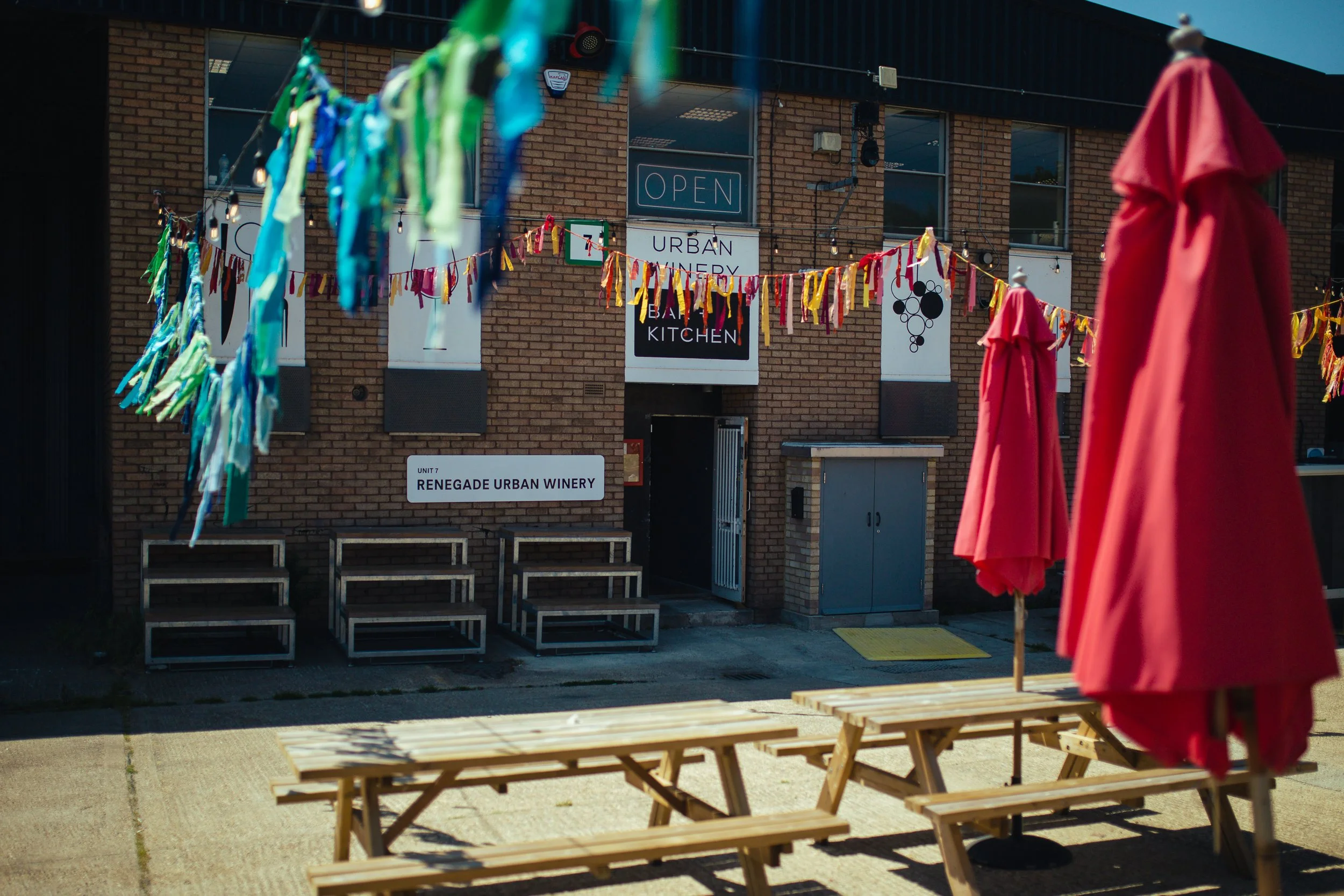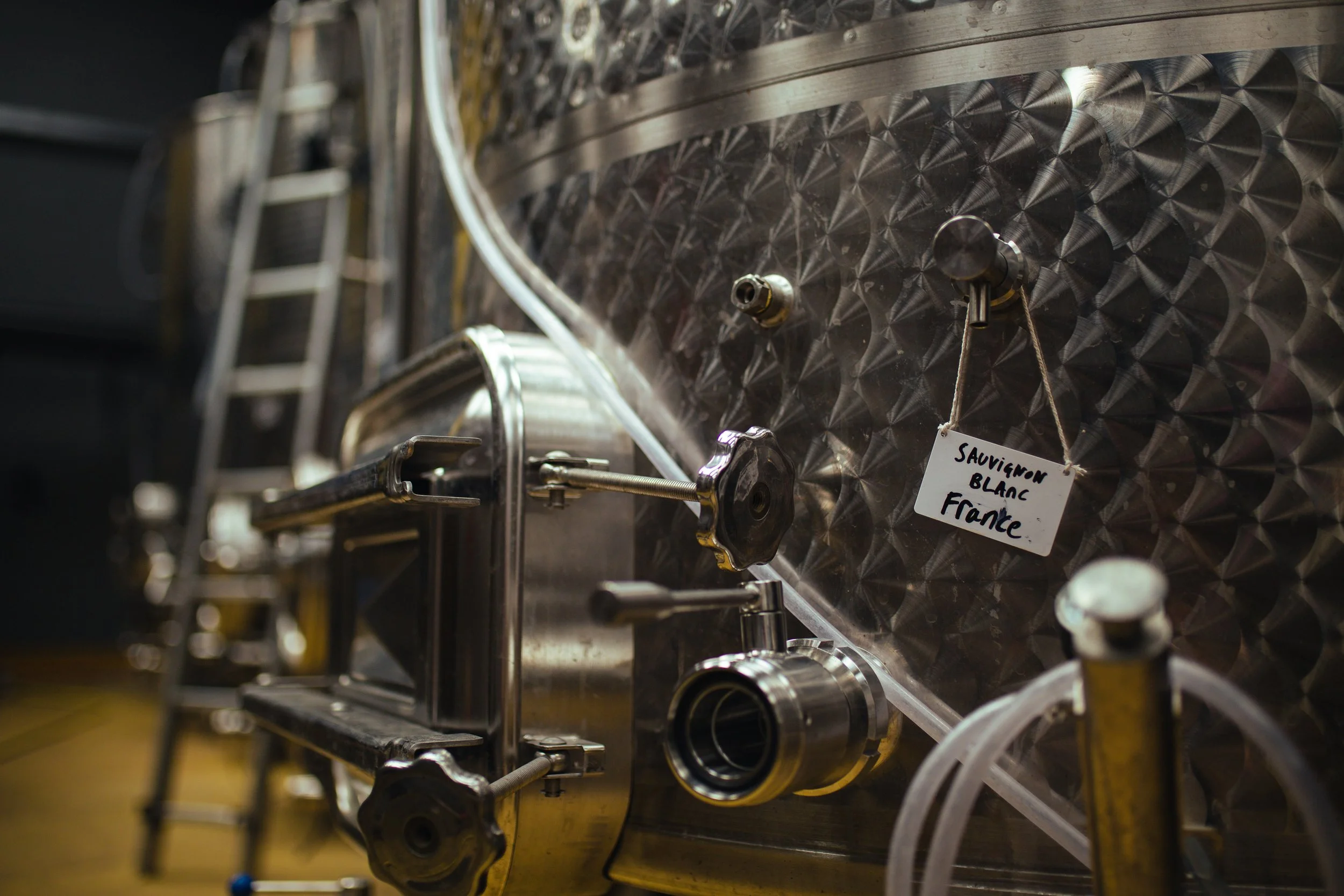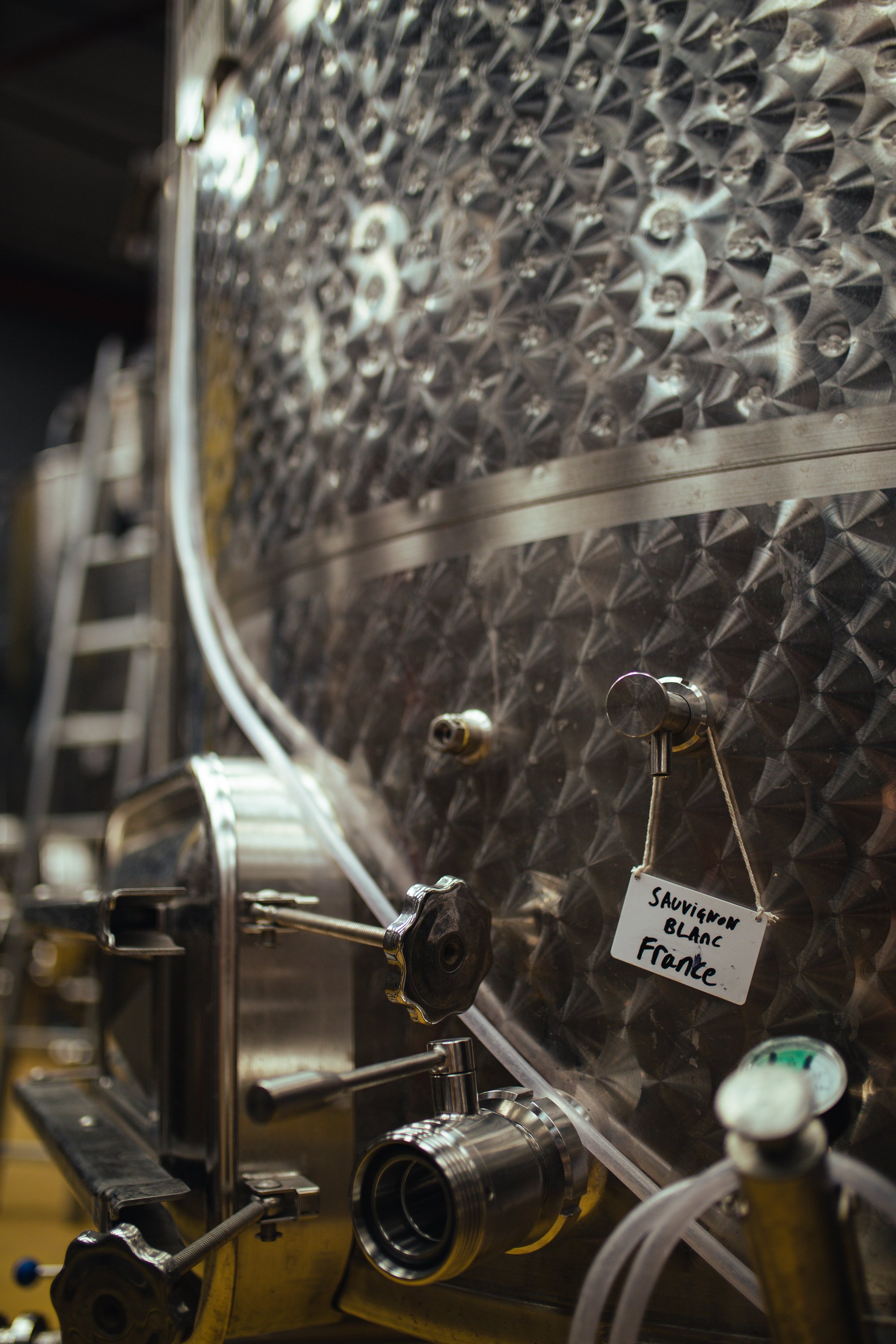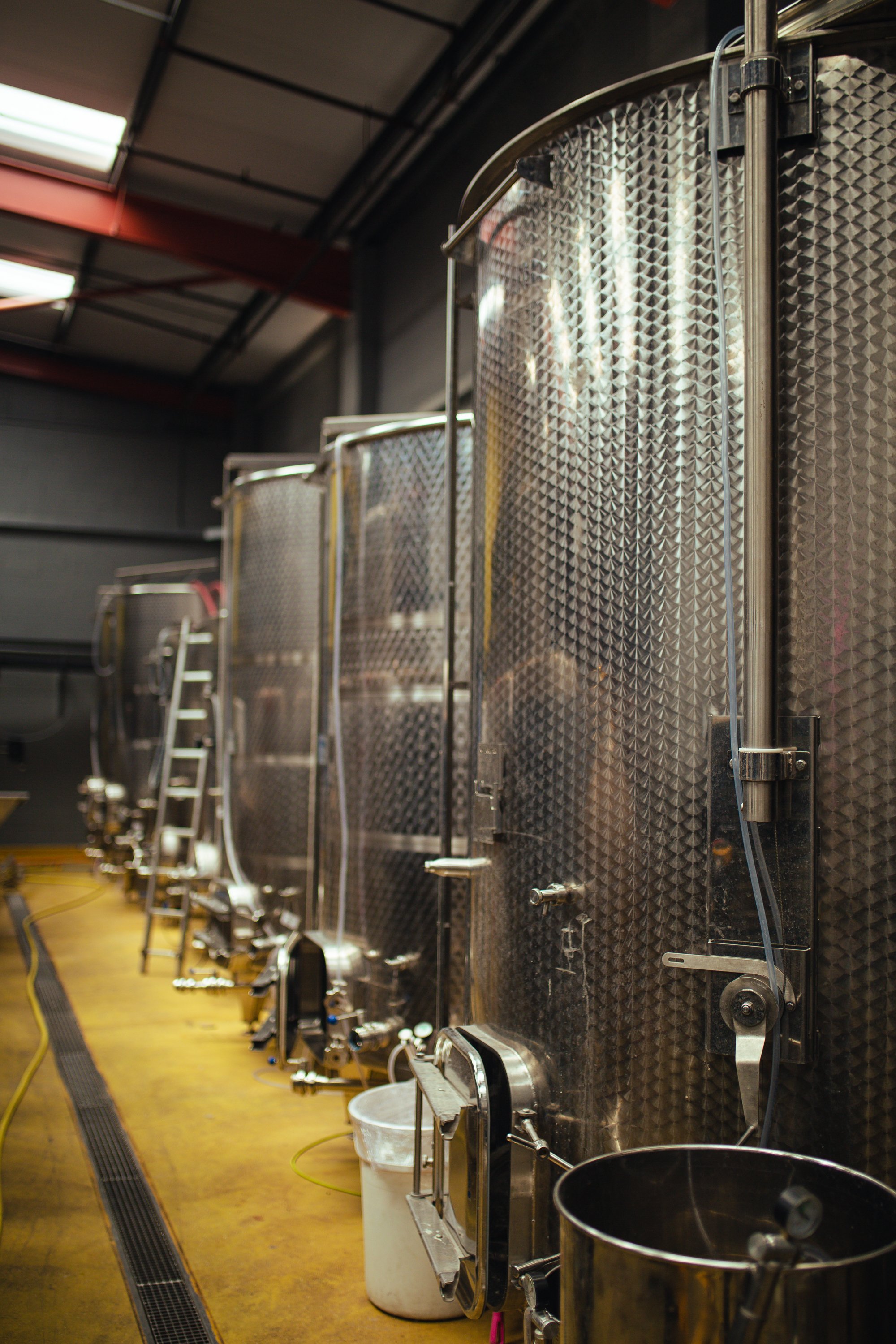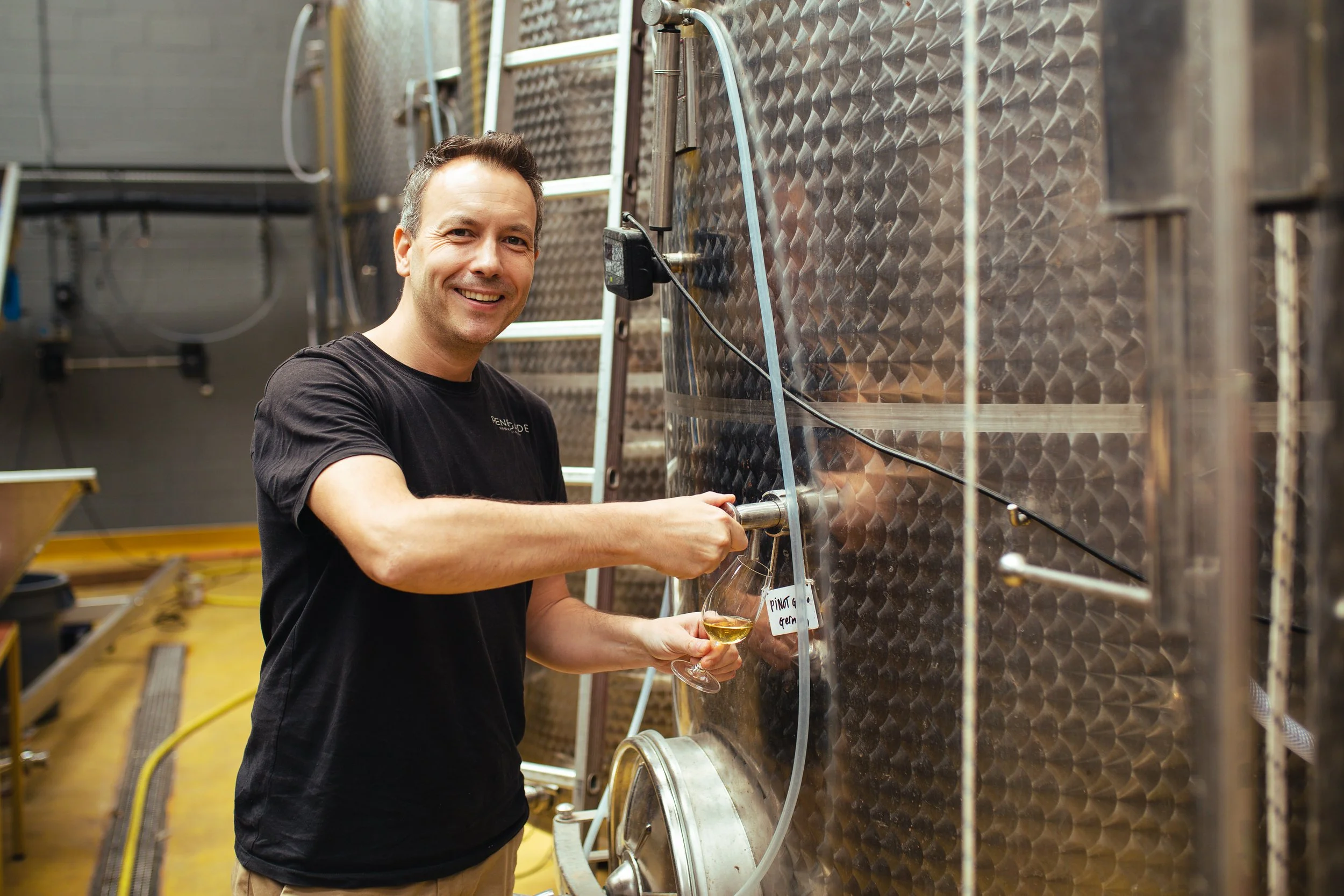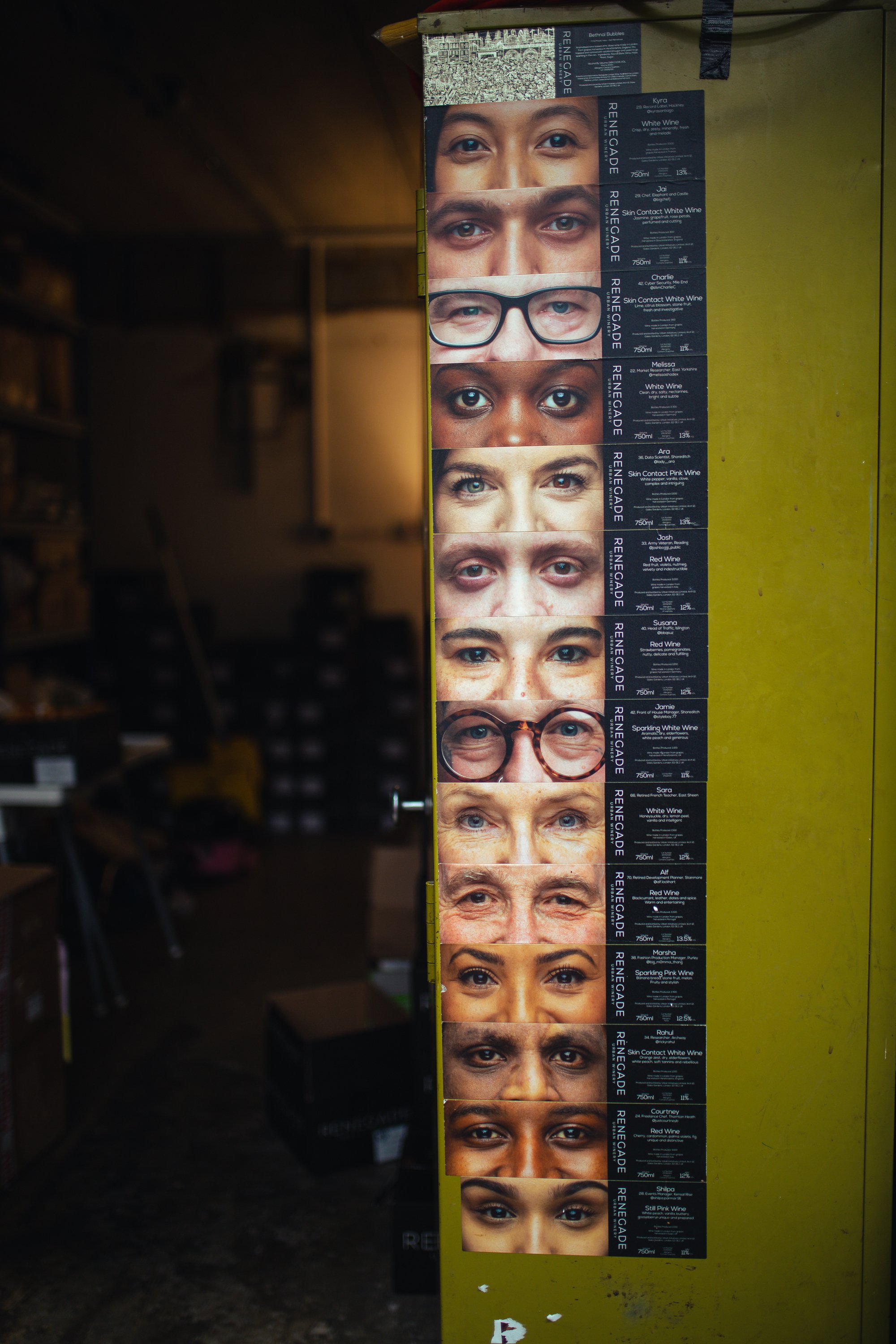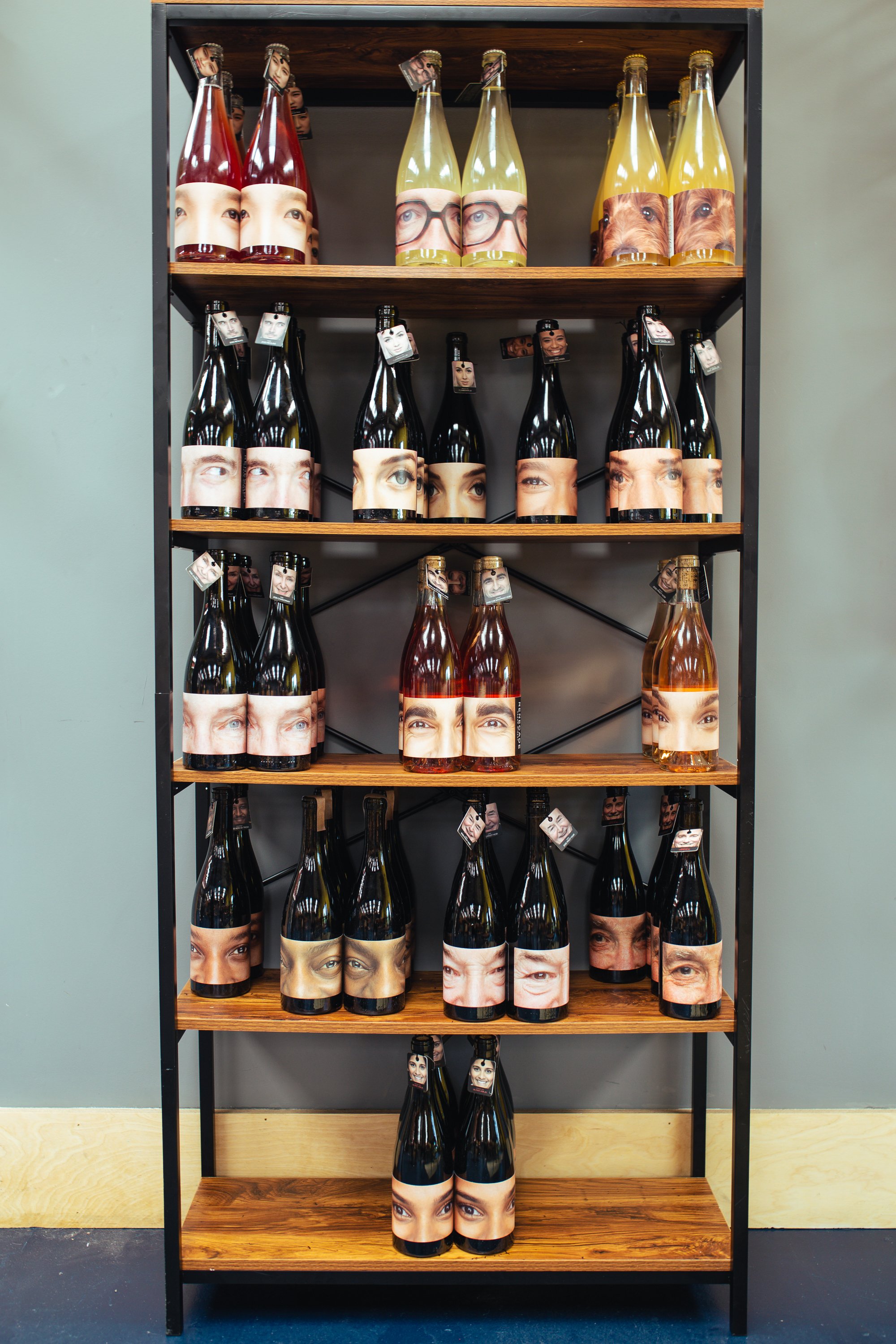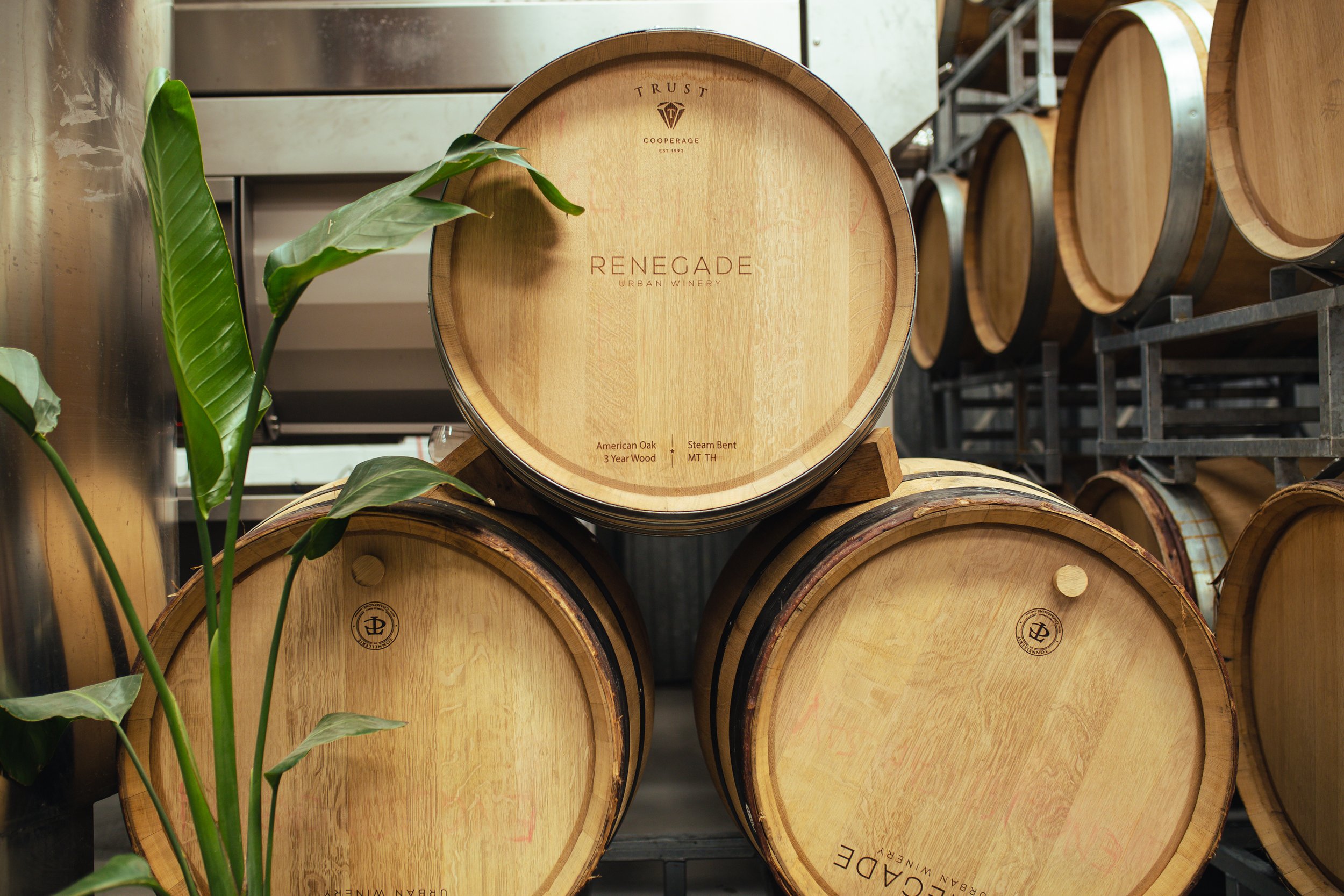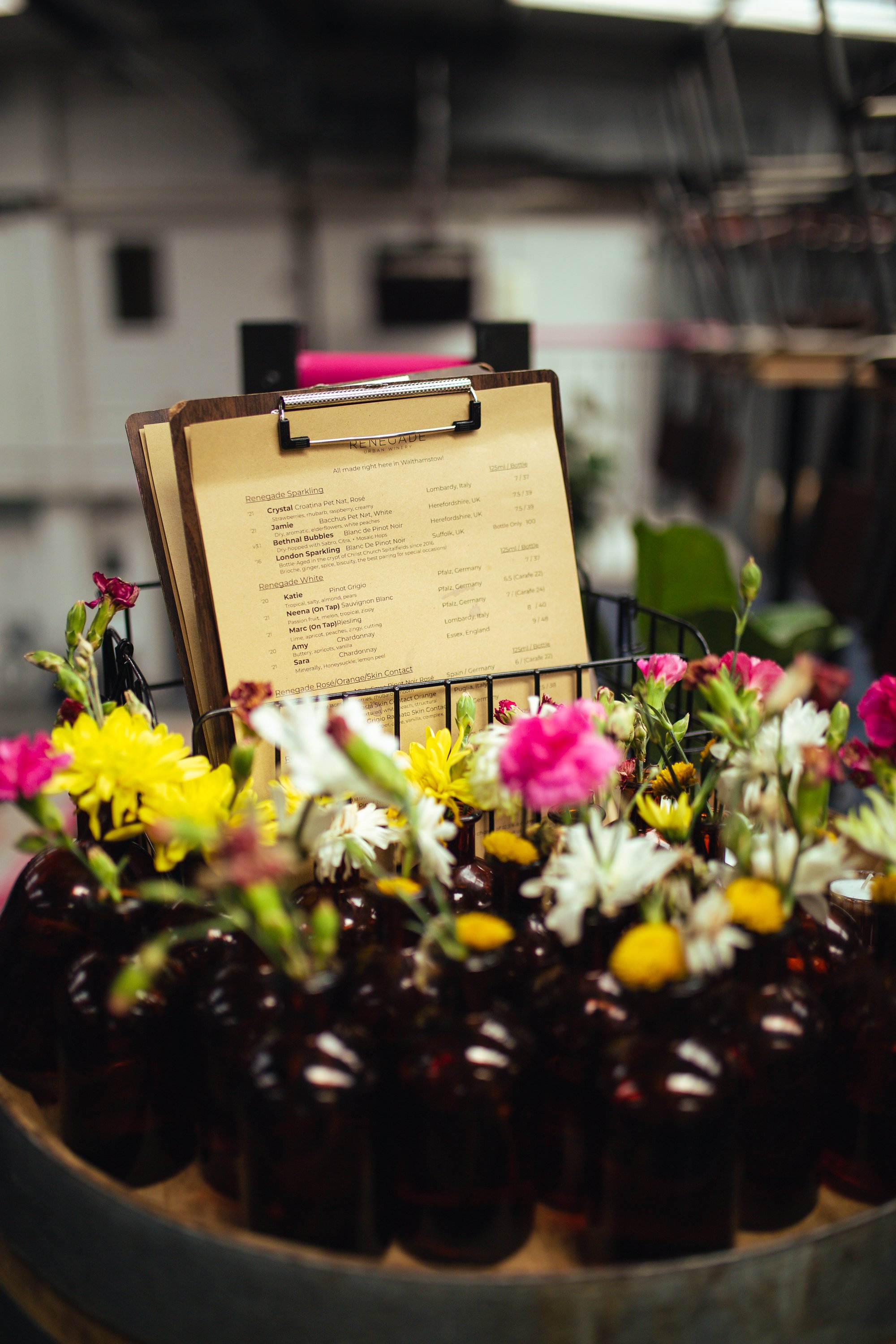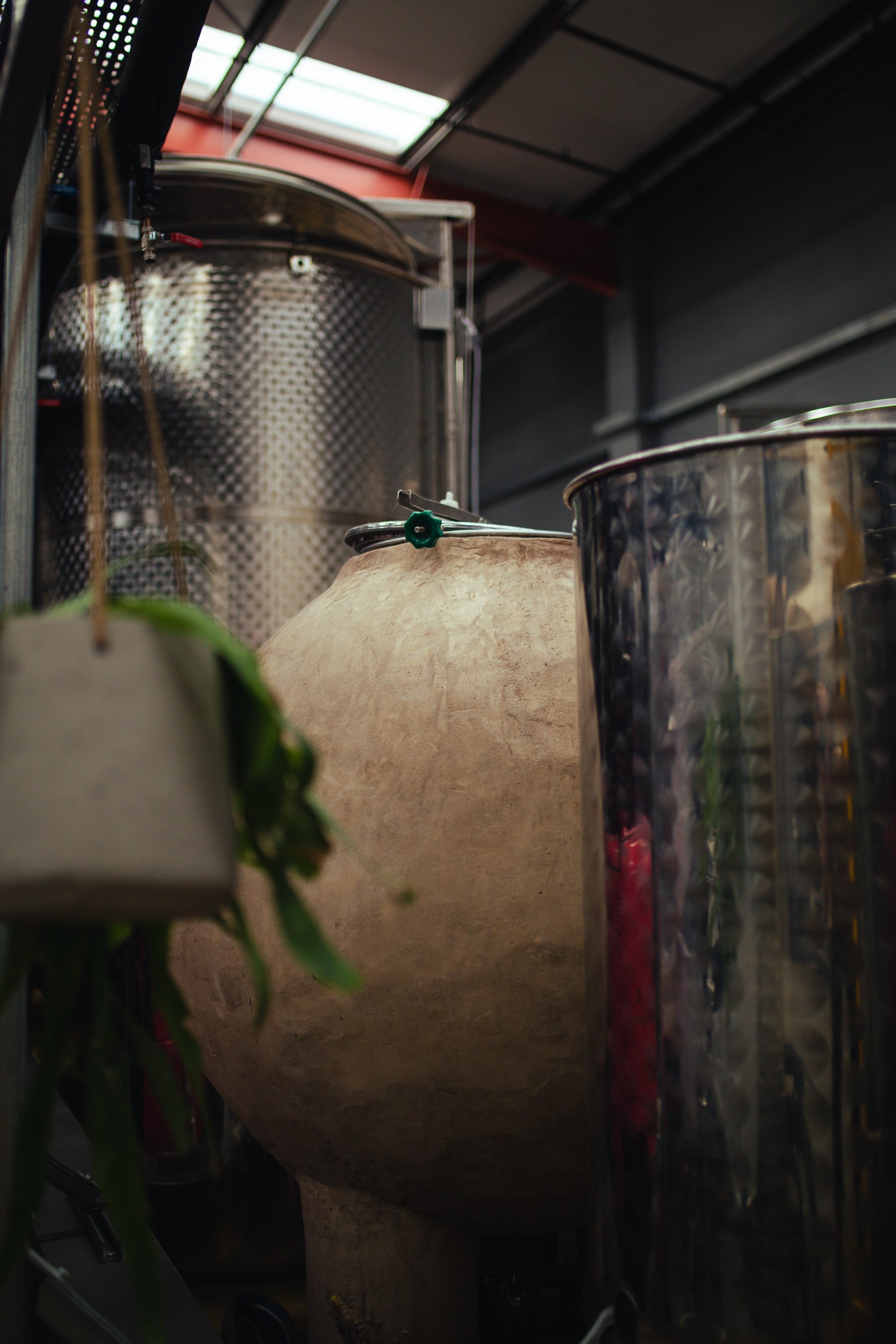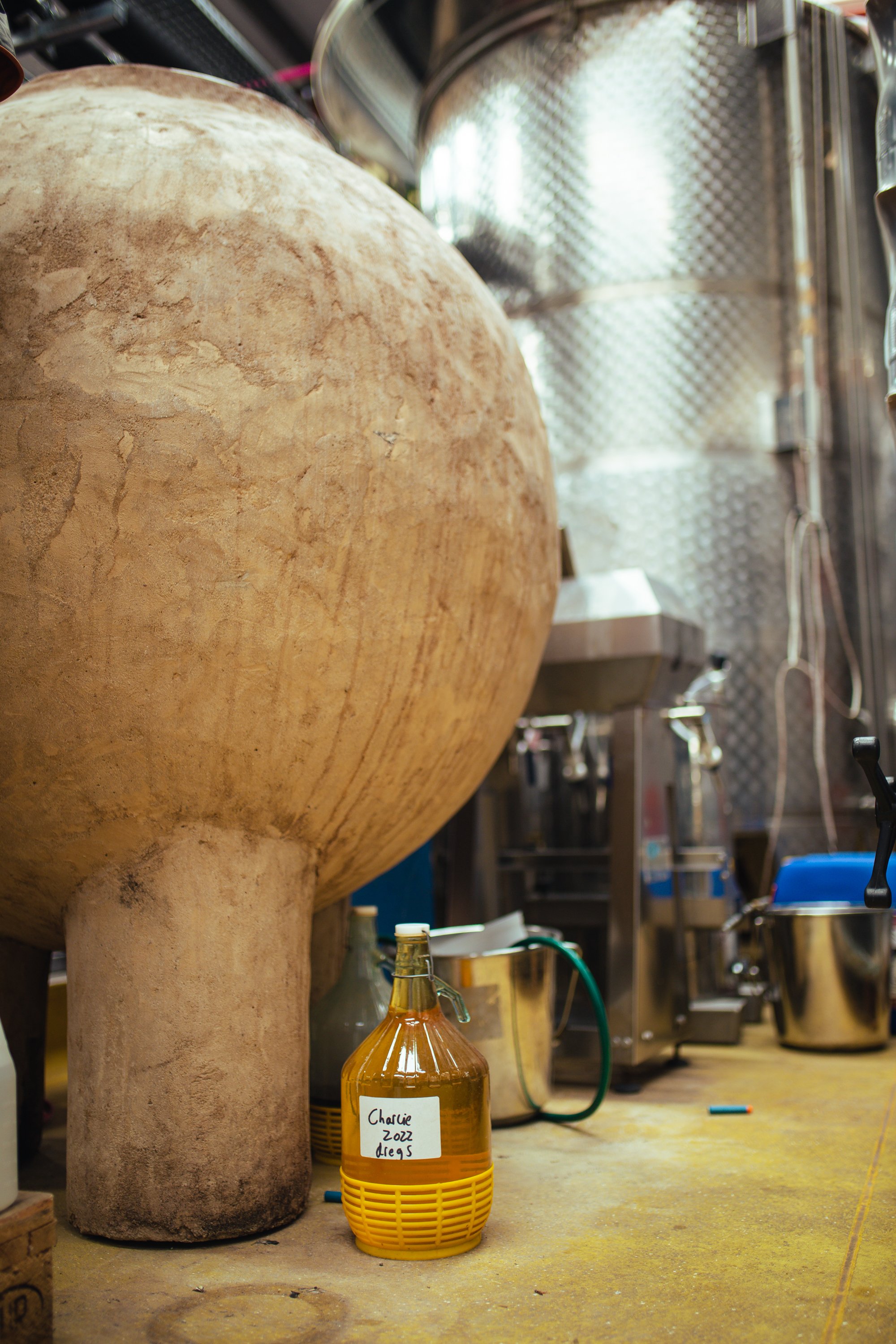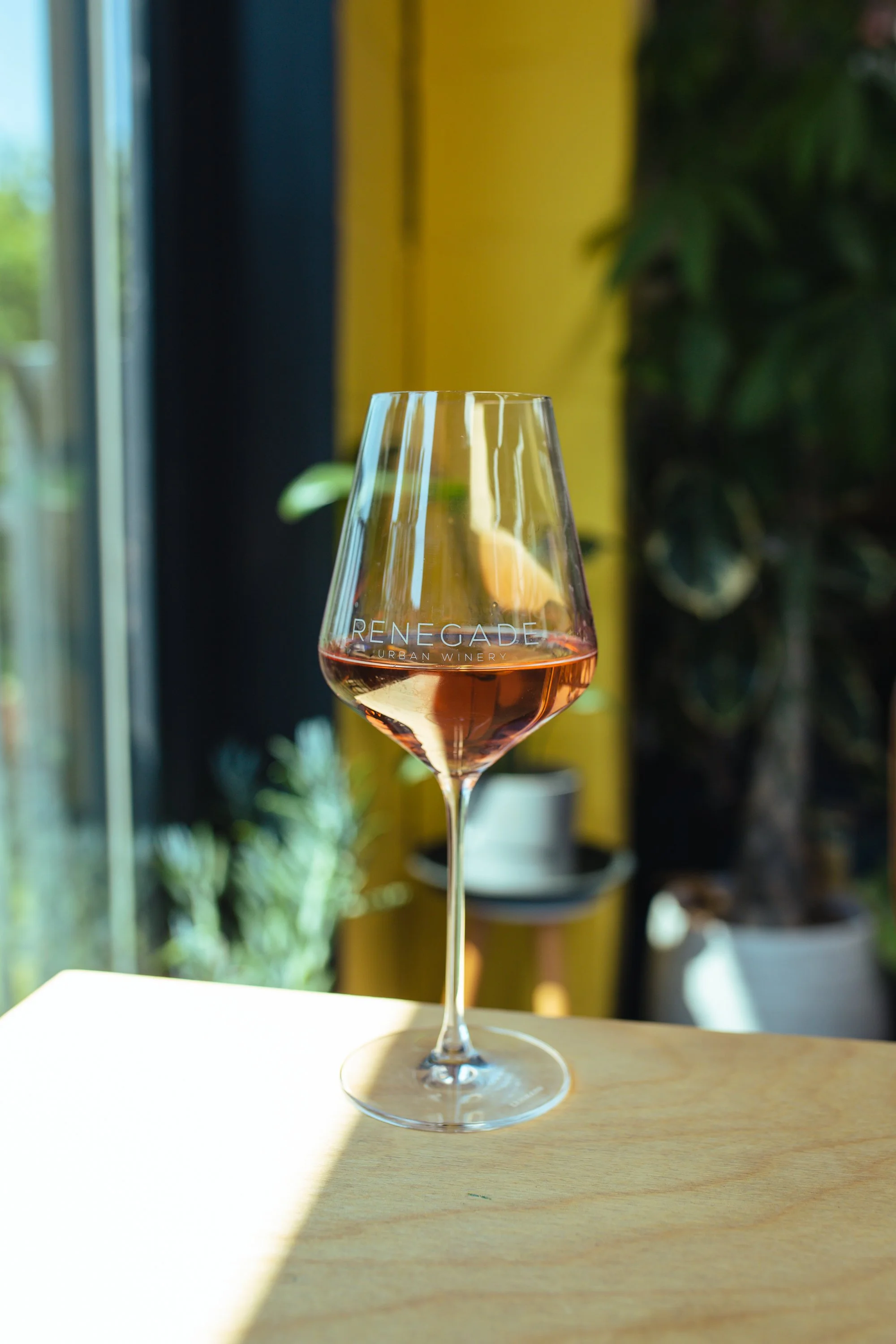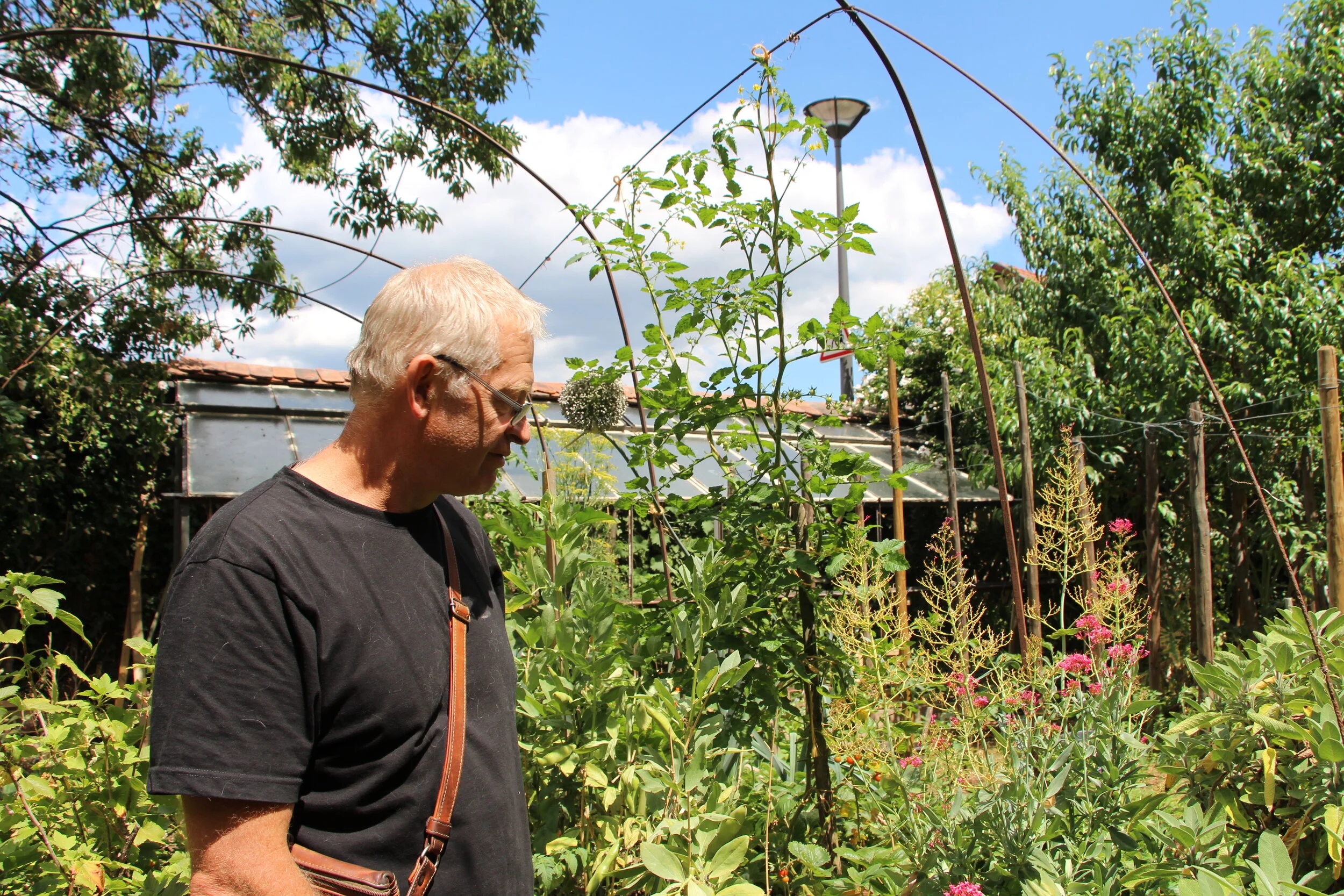Welcome to the Jungle — In Conversation With Warwick Smith of Renegade Urban Winery
The bâtonnage—the natural stirring of the lees, or fine yeast particulate—within the barrels of Renegade’s maturing wines used to be (at least in part) carried out by the rumbling of trains over their Bethnal Green railway arch. A claim not many winemakers can echo. Nowadays their thoroughly modern winery is perched vigilantly on the end of Lockwood Way in Walthamstow, overlooking a handful of brewery taprooms including Hackney Brewery, Signature Brew and Wild Card Brewery.
The winery sports its own mezzanine wine bar and restaurant, featuring a rotating cast of resident chefs. Most recently it hosted The Italians Upstairs, serving up a menu of Italian classics with modern flair, designed to pair with Renegade’s wines (several of which are made using Italian grapes).
Photography by Paddy Gardiner
Founder, Warwick Smith, takes me out back to a picnic bench in their new ‘wine garden’ to chat in the baking June sun. As we discuss Renegade’s journey from its nascent Bethnal Green days, to its—decidedly sparklier—new E17 hub, it becomes increasingly clear that Warwick feels like a progenitor of London’s Urban Wine scene. One who is trying to plot a fresh course in an increasingly challenging socio-economic landscape.
We retire into the cool shade of the winery, where dappled light reflects off the brushed stainless steel, and the buttercup yellow floor. The discussion turns to the tumultuous world events of the last few years, and how subsequently the production of boundary-pushing, singular wines, may need to give way to a wider-appeal product—and how, as always in life, a balance must be struck.
***
Paddy Gardiner: Tell me a little bit about your personal history with wine.
Warwick Smith: I grew up in a family that always liked a drink. Wine was often around. My first taste of wine was probably with lemonade—we used to call it a spritzer. I was probably around 11 when I was allowed to taste that. When I was 12 I went to boarding school in the South of France[...]that sounds really posh, but it was a kind of public school, and we were in the EU back then, so I didn’t have to pay or anything.
PG: Was that an English-speaking school?
WS: No, it was a French-speaking school, so I basically went to a French-speaking school in France as a teenager, without speaking a word of French! In France you were allowed to drink fermented alcohol at 14 years old, so we drank beer all the time. Kronenburg and all that[...] I drank wine a bit, and then all through my late teens and twenties I always liked wine.
The turning point for me was moving to Singapore when I was 27. I stayed there for seven years. Then in about 2010 Berry Bros. [& Rudd, Britain’s oldest wine and spirits merchant] opened their Asian offices in Hong Kong. Because I used to work in the financial sector, they thought I had loads of money, but I didn’t really, but I got invited to all these tastings. That’s when I started tasting these expensive wines and I started to think, “Oh, wine’s a bit more than I thought it was.” Then I really got into wine. In Asia, there’s a lot of Australian and New Zealand wines, and I really got into it[…]
I came back to London in 2014 and started working for another financial firm in Mayfair, and I basically lost the complete will to live. I was 34/35, and I thought: “life can not be this miserable all the time”. I was earning good money, but I was just so unhappy. I thought, “What else can I do”?
I stumbled upon this concept in the US called ‘Urban Wineries’—this idea of making wine in cities from grapes that weren’t grown there. It’s like craft brewing but in the wine space.
The evolution of cold-chain logistics has meant that you can pick grapes, keep them cold overnight, put them in a truck at 3°c , drive them to a winery in a different place, and vinify them.
““Hang on a minute, why does London not have ten of these?!” ”
I thought, “Hang on a minute, why does London not have ten of these?!” London is one of the world’s biggest wine markets. English wine is emerging, and craft beer has gone through an incredible evolution… What's next? London should love this shit!
I went around the world looking at loads of urban wineries. I spent some time in Colorado at The Infinite Monkey Theorem (ironically, set up by a guy from Tunbridge Wells), and I realised that it could work. It hadn’t worked historically in Europe, mainly because it had been attempted in ‘Old World’ countries where there was a lot more stigma. It had also been done in ways where there wasn’t enough direct to consumer interaction. There was no cellar door or taproom where people could come and kick the tyres.
PG: You mentioned Craft Beer. We’re sat in the middle of the burgeoning Black Horse Beer Mile. What kind of parallels do you see between Urban Winemaking and Craft Beer?
WS: There’s a massive crossover with what we do. In London, there are 4 urban wineries—Blackbook, Vagabond, London Cru and us. If the winemaker has been trained in Burgundy or South Africa or whatever, and you’ve learned a certain way, and you’ve come to make wine in London, or any urban environment, you’re generally predisposed to make styles of wine that you’ve learnt or that you enjoy. As a consequence, not all urban wineries are particularly disruptive.
What sets us apart is that I don’t come from a wine background or a craft beer background. We’ve hired some brilliant winemakers and told them to do things differently. I think the parallel for us, and the philosophy of Renegade, is to buy great fruit but do something different with it.
If you buy brilliant Chardonnay from Northern Italy now—knowing what you know about the region, what people want, the technology available, the yeast strains available, the fermentation profiles available etc—would you make it exactly the way they make it in Northern Italy? Probably not. Because they’ve done it that way for so long, and they exist within a DOCG [controlled appellation] category that they can’t move from, it’s continually made in that way. Whereas we were like, “Fuck it!” let’s do 20% skin contact, 50% in old Hungarian oak barrels, 50% in stainless for freshness, and let’s put 5% English Chardonnay in there to give more acidity… why not!
PG: Would you say that your philosophy of winemaking favours the process over the concept of terroir?
WS: I would say, at a brief level, yes. I used to be a bit of a terroir denier. I thought process mattered so much more. I’ve kind of come full circle. A lot of wine people tell you it’s 95% terroir and 5% making. I used to go the opposite way, but now I think that’s wrong too. I think it’s more like 50/50. Of course the climate and soil matter massively at a raw ingredient level, but that matters less in the finished fermented liquid, after oak and all those other inputs into it. I would say that we favour process more, but obviously terroir and quality of fruit is still a big consideration for us because we only really have one ingredient.
PG: I’ve had some of your wines before, Vern springs to mind, your Bordeaux-style blend made from Albanian fruit. Are the quality of fruit and supplier relationships more important for you than the prestige of fruit from specific regions?
WS: Oh absolutely, we don’t give a toss about prestige. In fact, we thought about buying Burgundian appellation fruit for a while, but there’s no point in us paying such a premium for a product when there’s other brilliant fruit available all over Europe. Climate change has also changed things a lot, everything’s getting warmer. We just want to find great fruit.
Getting back to your point about producers, their ability to work well with us is really important too.
PG: What concerns are there around the carbon footprint of fruit shipped to an urban winery from all over the continent?
WS: Well I think we want to make more wines from English grapes, because they are getting better and better, and we’re understanding it more and more. Sadly English fruit is still a volatile pricing market, and the vintages here are still very variable.
PG: We’re still seeing a lot of issues with frost and rain here that are affecting yields and quality.
WS: Exactly. So I think we never want to be 100% English, but we’d like to do more and more. That said, my argument around the sustainability side of bringing fruit in is that we only use road transport and ferries, we don’t use any air freight. We only bring in fresh bunches of grapes in reusable crates. The only impact carbon footprint-wise is the journey from the vineyard.
The truth is that any wine that you buy from outside of the UK will have travelled that journey, but usually in a heavy glass bottle, and often rerouted around various storage facilities and distributors. If you eat or drink anything you haven’t grown yourself, then it has to have travelled. Then it’s about minimising impact, which [for us] looks like reusable crates and only using road transport.
PG: We’re seeing a lot more bag-in-box and other environmentally conscious packaging solutions for wine. Have you played with these formats, or are you married to glass bottles?
WS: Absolutely, completely not married to glass bottles! I love bag-in-box, wine in keg, Tetra Pak, ‘bagnums’... The whole shebang. We’ve tried cans, and we’ll do them again. We do wine in keg and will keep doing it. The reason we don’t do it on a bigger scale is, firstly, we’re not actually that big, and we don’t really have the machines required. Secondly, because it costs quite a lot to make our wines; the pricing for the consumer is quite premium. As a consequence, if it was in a paper bottle, or something super lightweight, I think people would struggle to pay that price. There’s still a consumer perception that wines of a certain price have to be in a glass bottle.
PG: Is Renegade exclusively a premium wine brand then?
WS: Our plan is to continue making these ‘grape to glass’ wines that we love making, that are innovative, artisanal, and interesting, but we are looking to try to enter a slightly more entry-level and accessible price point market. That might mean that we don’t do everything in-house. Maybe we’ll press somewhere else, or do some blending. Maybe we’ll bottle somewhere else. But if we can get these wines right at a lower price point then they’ll be perfect for cans and kegs! We can’t forget that we’re in a cost-of-living crisis. During covid people decided to drink better and less, but the truth now is that people are struggling. I think this lower price point offering is where the growth is in our business.
PG: Do you think there’s a marketing challenge with English varietal wines? When Chardonnay and Pinot Grigio are ‘brands’ in their own right, do you think there’s a problem in trying to market lesser-known English wines like Madeleine Angevine to the drinking public?
WS: I have a lot of opinions on the English wine world. I think the first thing to say is that the wines you’re talking about are still wines. I think still wines only account for about 5% of wine production in the UK. 95% is sparkling wine [this is closer to 68% sparkling and 32% still, according to WineGB’s annual report] made using the Champagne method and mostly using the three Champagne varieties [Chardonnay, Pinot Noir, Pinot Meunier]. I think that the consumption of English still wines isn’t very high, and is probably led by Chapel Down.
What happened initially in England is that they planted varieties that were well suited to our climate, like Bacchus, Madeleine Angevine and Reichensteiner. As the UK grew its sparkling wine market, and went for a bit of a Champagne copycat style, they planted those three traditional continental varieties. I think only in the last decade or so, with climate change, people are thinking that we could use these varieties for serious still wines.
In truth what I think we should be planting are interesting hybrid varieties. They could be more disease resistant and easier to farm but would have weird names that the consumer wouldn’t recognise. My view is that if we grow great grapes, then we can make great wine and sell it, but it’s definitely a gamble for the grower.
England, in the history of wine, has a very short history. We have an opportunity to create new styles, new formats, a whole new world of innovation in wine for a new generation and a modern palate. We shouldn’t be copying anyone else. On that note, shoutout to all the incredible English winemakers doing bold things, and pushing the boundaries.
PG: Tell me a bit about your labels and your design aesthetic. There aren’t many other wine brands labelling their bottles with the eyeballs of their customers.
WS: After working with some artists for the first couple of years, we decided to do it ourselves. The thinking is, “who are the most important people to us?”, and that’s our customers. Then we thought, “why are wine labels so text driven?”, and that of course is because all the famous winemakers have been releasing wine since before photo printing. We realised we could put photos on our labels, and who better to feature than our customers. We started doing that in 2018. For the wines that we release every year, we feature the same person on each vintage, but with an updated photo. Sara on the 2019 vintage is the same Sara on the 2020 vintage, photographed a year apart.
““This might be controversial to many, but I honestly believe no wine is natural.””
PG: What’s the balance of perennial wines in your portfolio, that you make every year, versus new or one-off wines?
WS: We make about 15 wines a year, and 10-12 will stay the same. Every year we look for about 3 new faces for those new wines.
PG: For those new wines, where does the inspiration come from? Is it the offer of specific fruit, or the vision of a finished wine?
WS: A bit of both. We knew we wanted to make an aromatic, skin contact, English white, so we did that with Madeleine Angevine, and with Bacchus. We knew that our vineyard we work with in Northern Italy grows great Barbera, but we didn’t want to make a red like everyone else, so we made a rosé from it. Our grower in Herefordshire had been developing some English-grown Cabernet Sauvignon, grown partially under polytunnel to let it achieve ripeness. We worked with them on the idea of a white Cab Sauv. We googled around the world to see if anyone had done it, and we couldn’t find any, maybe one in Australia. We were thinking, “Wow! Why has no one done this?”
The obvious conclusion is that it’s not possible, or it’s shit. We tried it anyway, we whole bunch pressed the grapes, and it immediately became clear that the colour extraction was super heavy. That wine’s still in barrel, we don’t know what it will be yet. If we were more interventionist in our winemaking, we could strip the colour out with a charcoal filter, like a lot of Provence rosé. We don’t have a charcoal filter, but we wouldn’t do that if we could. We’re just letting it do its thing. The barrel won’t hurt it but we do lose a few litres every month to the ‘angel’s share’ of evaporation.
PG: You mentioned your low-intervention approach to winemaking. Would you call your wines ‘Natural Wine’?
WS: This might be controversial to many, but I honestly believe no wine is natural. Look at all the vineyards in the world. Almost exclusively planted in straight rows. That land used to be forests, scrub, bushland… Nature has been ripped out to plant vines on a piece of land, on grafted roots, in conventionally structured vineyards—even if they’re organic or biodynamic. Fermentation, even if you’re using ‘natural’ or native yeasts has to be managed, temperature, oxidation, cap management… you arguably have to be more hands-on when using native yeasts than when you’re inoculating with a cultured yeast. Sulphur is produced during fermentation, regardless of whether you add extra.
PG: Do you employ some added sulphur with a light hand?
WS: We do. We like to add some sulphur to ageing wine in barrel, if it needs it, and at bottling for a bit of extra protection. We don’t add any to our pet-nat, because it’s protected in bottle by the secondary fermentation.
All of our fruit is organically grown, none of our wine is filtered, we inoculate about 50% and the other half is spontaneous. Our wines were all spontaneous in our Bethnal Green arch, but this new facility in Walthamstow doesn’t have the same micro-flora.
PG: Finally, what does the future look like for Renegade?
WS: The first thing to say is that if I’d known in 2016 that winemaking in a city like London would be so hard on my mental and physical health, and my relationships—that it would cost so much more to get started—that we would go through Brexit, a pandemic, a war, a cost of living crisis[…] I don’t think any sane person would’ve started. What I’m trying to say is that it’s so hard out there. I think the future for Renegade is to continue to do what we do, but to work harder on our marketing and awareness.
I still say that 95% of Londoners still have no idea that wine is made in London. I think the future of Renegade is also to try and make a more affordable price point range. We have to move with the market. Just like during the pandemic we went direct to consumer and opened our own shops, now in a cost of living crisis we have to create a product that works for the consumer in order to survive.



